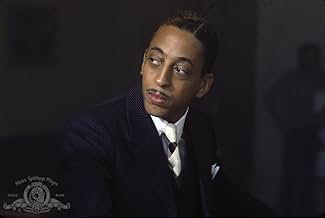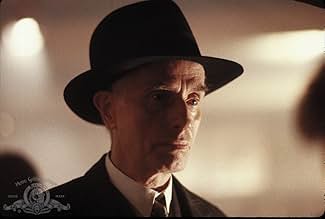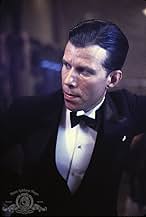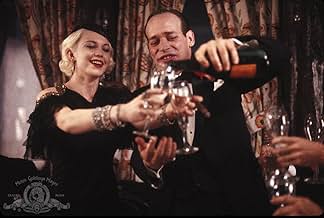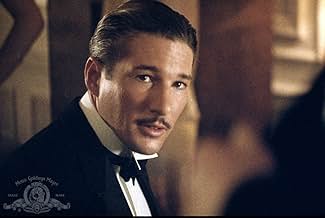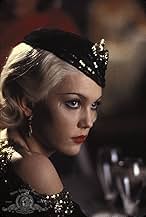IMDb रेटिंग
6.6/10
21 हज़ार
आपकी रेटिंग
मिलिए, सन् 1928-30 के हार्लेम के द कॉटन क्लब के जैज़ संगीतकार, डांसर, मालिक और मेहमान से.मिलिए, सन् 1928-30 के हार्लेम के द कॉटन क्लब के जैज़ संगीतकार, डांसर, मालिक और मेहमान से.मिलिए, सन् 1928-30 के हार्लेम के द कॉटन क्लब के जैज़ संगीतकार, डांसर, मालिक और मेहमान से.
- 2 ऑस्कर के लिए नामांकित
- 1 जीत और कुल 9 नामांकन
Laurence Fishburne
- Bumpy Rhodes
- (as Larry Fishburne)
John P. Ryan
- Joe Flynn
- (as John Ryan)
फ़ीचर्ड समीक्षाएं
One gets the sense that 'The Cotton Club (1984)' will improve upon repeat viewings, once you've become accustomed to what director Francis Ford Coppola was attempting. After all, this is a gangster film from the man who brought us 'The Godfather (1972)' and its sequels – what else could we expect but another Corleone saga? The film we're delivered is nothing of the sort, a testament to the director's constant willingness to take risks and experiment with new ideas. Indeed, rather than trying to emulate Coppola's former successes, 'The Cotton Club' could more accurately be described as a "gangster musical," a realisation that took me until the film's second half. Do those two genres even go together? Perhaps taking inspiration from Herbert Ross' 'Pennies from Heaven (1981)' – and the mini-series on which it was based – the film blends the ugly brutality and corruption of the Prohibition- era with the dazzling bright lights of the Cotton Club, Harlem's premiere night club. It is this deliberate but uneasy juxtaposition of reality and fantasy that fuels Coppola's vision, an ambitious undertaking without a dominant focus.
The film's major storyline concerns Dixie Dwyer (Richard Gere), a comparatively ordinary jazz musician who unexpectedly finds himself associating with organised crime boss "Dutch" Schultz (James Remar). Dixie is interesting because, unlike your typical hero consumed by the allure of amoral riches, he always remains peripheral to the world of gangsters; he observes, with disapproval, its dishonesty and depravity, but rarely finds himself a part of it. In fact, the closest he ever comes to being a gangster is in Hollywood, where he shares the sort of film roles that made James Cagney and Edward G. Robinson famous. Coppola might have been offering a commentary on the inherently romanticised version of reality offered by the movies, but his "real world" of gangsters is scarcely less stylised. The seedy underbelly of organised crime is paradoxically depicted as taking place in the classiest locales in Harlem, where the crime bosses consume the best alcohol and mix with Hollywood's elite talent (Chaplin, Swanson and Cagney among the featured patrons).
Proving further that Coppola wasn't attempting to replicate his Corleone saga, 'The Cotton Club' also features a rather extraneous subplot with Maurice and Gregory Hines as African-American tap-dancers vying for the "big-time" at the Cotton Club, where (in a bizarre discriminatory switch) only black performers are hired. The regular cross-cutting between this story and Dixie Dwyer's doesn't quite work, and, in any case, the taut romance between Dwyer and tough-girl Vera (an absolutely gorgeous Diane Lane) is much more involving than that between Sandman Williams (Gregory Hines) and mixed-race dancer Lila (Lonette McKee). Among the film's impressive supporting performers are Bob Hoskins and Fred Gwynne as crime associates, Nicholas Cage as an overly-ambitious young thug, Laurence Fishburne as black crime boss Bumpy Rhodes, and James Remar, playing a sleazier and less identifiable version of Dutch Schultz to Dustin Hoffman in 'Billy Bathgate (1991).' The premiere gangster film of 1984 was Leone's 'Once Upon a Time in America (1984),' but, despite being runner-up, nobody can accuse Coppola of playing it safe.
The film's major storyline concerns Dixie Dwyer (Richard Gere), a comparatively ordinary jazz musician who unexpectedly finds himself associating with organised crime boss "Dutch" Schultz (James Remar). Dixie is interesting because, unlike your typical hero consumed by the allure of amoral riches, he always remains peripheral to the world of gangsters; he observes, with disapproval, its dishonesty and depravity, but rarely finds himself a part of it. In fact, the closest he ever comes to being a gangster is in Hollywood, where he shares the sort of film roles that made James Cagney and Edward G. Robinson famous. Coppola might have been offering a commentary on the inherently romanticised version of reality offered by the movies, but his "real world" of gangsters is scarcely less stylised. The seedy underbelly of organised crime is paradoxically depicted as taking place in the classiest locales in Harlem, where the crime bosses consume the best alcohol and mix with Hollywood's elite talent (Chaplin, Swanson and Cagney among the featured patrons).
Proving further that Coppola wasn't attempting to replicate his Corleone saga, 'The Cotton Club' also features a rather extraneous subplot with Maurice and Gregory Hines as African-American tap-dancers vying for the "big-time" at the Cotton Club, where (in a bizarre discriminatory switch) only black performers are hired. The regular cross-cutting between this story and Dixie Dwyer's doesn't quite work, and, in any case, the taut romance between Dwyer and tough-girl Vera (an absolutely gorgeous Diane Lane) is much more involving than that between Sandman Williams (Gregory Hines) and mixed-race dancer Lila (Lonette McKee). Among the film's impressive supporting performers are Bob Hoskins and Fred Gwynne as crime associates, Nicholas Cage as an overly-ambitious young thug, Laurence Fishburne as black crime boss Bumpy Rhodes, and James Remar, playing a sleazier and less identifiable version of Dutch Schultz to Dustin Hoffman in 'Billy Bathgate (1991).' The premiere gangster film of 1984 was Leone's 'Once Upon a Time in America (1984),' but, despite being runner-up, nobody can accuse Coppola of playing it safe.
Part fictional and part non-fictional, this lavish two-hour Francis Ford Coppola film spotlights the Cotton Club, the legendary, real-life Harlem jazz nightclub that flourished in the Prohibition era of the late 1920s and early 1930s. Richard Gere plays Dixie Dwyer, a young musician who works for mobsters, in an effort to advance his career. Dwyer falls in love with Vera Cicero (Diane Lane), the girlfriend of gangster Dutch Schultz (James Remar). The Dwyer character is based loosely on real-life jazz trumpet player Bix Beiderbecke.
Throughout the film, various gangsters and bootleggers interact, sometimes violently, but much of the action centers around the Cotton Club, an establishment owned in real-life by Owney Madden, played in the film by actor Bob Hoskins. Madden would bring in Black performers to entertain a Whites-only clientèle, a truly racist policy, and a major plot point in the film's story.
The film's plot is somewhat muddled, the result of a less than stellar screenplay. And, as you would expect, the gangster characters are not terribly likable. But the film overcomes these script weaknesses with a captivating visual and musical style that is both tawdry and elegant. The corruption, the violence, and the implied sleaze are garish and tawdry to be sure. Yet, the Club's ambiance gushes with a certain elegance and glamour. It's a strange mix, but one that is entirely consistent with that era in U.S. history.
The film gets points from me for its lush, period piece costumes and production design, and adroit lighting, as well as all those jazz numbers, both sultry and flashy. Gregory Hines together with brother Maurice Hines provide some snappy tap dancing, some of which is improvised. Interestingly, their grandmother really did perform at the Cotton Club during its heyday. Also of interest in the film, viewers get to watch towering Fred Gwynne, who plays Frenchy, the oh-so-serious assistant to Owney Madden; the two of them engage in some interesting dialogue.
Although the script's story and characters are less than ideal, I enjoyed the film a lot, mostly as a result of the tawdry and elegant visual style combined with the lavish jazz numbers. If you're interested in gangster movies or the Prohibition era of American history, this film is a must-see.
Throughout the film, various gangsters and bootleggers interact, sometimes violently, but much of the action centers around the Cotton Club, an establishment owned in real-life by Owney Madden, played in the film by actor Bob Hoskins. Madden would bring in Black performers to entertain a Whites-only clientèle, a truly racist policy, and a major plot point in the film's story.
The film's plot is somewhat muddled, the result of a less than stellar screenplay. And, as you would expect, the gangster characters are not terribly likable. But the film overcomes these script weaknesses with a captivating visual and musical style that is both tawdry and elegant. The corruption, the violence, and the implied sleaze are garish and tawdry to be sure. Yet, the Club's ambiance gushes with a certain elegance and glamour. It's a strange mix, but one that is entirely consistent with that era in U.S. history.
The film gets points from me for its lush, period piece costumes and production design, and adroit lighting, as well as all those jazz numbers, both sultry and flashy. Gregory Hines together with brother Maurice Hines provide some snappy tap dancing, some of which is improvised. Interestingly, their grandmother really did perform at the Cotton Club during its heyday. Also of interest in the film, viewers get to watch towering Fred Gwynne, who plays Frenchy, the oh-so-serious assistant to Owney Madden; the two of them engage in some interesting dialogue.
Although the script's story and characters are less than ideal, I enjoyed the film a lot, mostly as a result of the tawdry and elegant visual style combined with the lavish jazz numbers. If you're interested in gangster movies or the Prohibition era of American history, this film is a must-see.
The Cotton Club is a dazzling, complex film that attempts so much it would be almost impossible for nearly any director to pull it off. But Francis Ford Coppola is not any director, so The Cotton Club is not just any movie. Rather, it succeeds at practically all levels and is certainly a film worth coming back to again and again.
Set in Harlem in the late 1920s, we are introduced to a group of Jazz Age-products, people who see themselves exactly as they are but all hope to go somewhere better. Two story lines occupy the plot; we get a good-looking young musician Dixie Dwyer (Richard Gere) who gets involved in the mob after falling for one of the gangster's girlfriends (Diane Lane) and we get the story of a very talented black dancer (Gregory Hines) trying to prove his love to a half-black and half-white chorus girl who seems to struggle with her place in this more or less racist society. Almost every night, everyone gathers at The Cotton Club, one of the most famous clubs in the city and the blacks entertain while the whites drink and watch. But Coppola gives us a view from all angles so it doesn't feel as if we are missing anything important.
One of the biggest achievements of this film is its staging of the dance sequences, which are to say the least quite exquisite. Filled with colorful costumes and some mind-boggling tap numbers, at times you may forget that this is also a gangster picture. Indeed, some scenes feel just like Coppola's The Godfather with its quick bursts of violence but also in its tone of sad, elegiac setting. People come and go and some regret the things they do, but the music lives on. The acting is also very strong as Gere and Lane are quite wonderful in their first of three films together. Both were very good-looking and they do bring out the best in each other. Two supporting actors that really do steal the show are Bob Hoskins and Fred Gwynne as a mob boss and his head bodyguard. They share a tenacity and ferociousness in their dealings, but also have one really terrific scene involving Gwynne coming to see Hoskins after being kidnapped. A young Nicolas Cage also shows here he had incredible potential.
This Broadway version of the gangster film so familiar in Hollywood refreshes both genres as we see the similarities between the two. Indeed, many of the participators in the entertainment were also involved in the mob and Coppola shows how the two lives intertwine and bring a lot of trouble to everyone. This may seem as a strange mixing of genres and story lines for some people, but it is well worth the two hours. It is funny, sad, violent, poetic but also enormously entertaining and isn't that what the movies are all about? Coppola seems to think so.
Set in Harlem in the late 1920s, we are introduced to a group of Jazz Age-products, people who see themselves exactly as they are but all hope to go somewhere better. Two story lines occupy the plot; we get a good-looking young musician Dixie Dwyer (Richard Gere) who gets involved in the mob after falling for one of the gangster's girlfriends (Diane Lane) and we get the story of a very talented black dancer (Gregory Hines) trying to prove his love to a half-black and half-white chorus girl who seems to struggle with her place in this more or less racist society. Almost every night, everyone gathers at The Cotton Club, one of the most famous clubs in the city and the blacks entertain while the whites drink and watch. But Coppola gives us a view from all angles so it doesn't feel as if we are missing anything important.
One of the biggest achievements of this film is its staging of the dance sequences, which are to say the least quite exquisite. Filled with colorful costumes and some mind-boggling tap numbers, at times you may forget that this is also a gangster picture. Indeed, some scenes feel just like Coppola's The Godfather with its quick bursts of violence but also in its tone of sad, elegiac setting. People come and go and some regret the things they do, but the music lives on. The acting is also very strong as Gere and Lane are quite wonderful in their first of three films together. Both were very good-looking and they do bring out the best in each other. Two supporting actors that really do steal the show are Bob Hoskins and Fred Gwynne as a mob boss and his head bodyguard. They share a tenacity and ferociousness in their dealings, but also have one really terrific scene involving Gwynne coming to see Hoskins after being kidnapped. A young Nicolas Cage also shows here he had incredible potential.
This Broadway version of the gangster film so familiar in Hollywood refreshes both genres as we see the similarities between the two. Indeed, many of the participators in the entertainment were also involved in the mob and Coppola shows how the two lives intertwine and bring a lot of trouble to everyone. This may seem as a strange mixing of genres and story lines for some people, but it is well worth the two hours. It is funny, sad, violent, poetic but also enormously entertaining and isn't that what the movies are all about? Coppola seems to think so.
This is a great movie. I personally don't think the beautiful Diane Lane could be in a bad flick, she would make the worst one good. I was impressed with Richard Geres musical ability as he played his own coronet and sounded as good as anyone I've ever heard. The dancing was superb, the costumes beautiful and the plot authentic. It took me back to the great musicals of the forties and fifties. I was raised in the waning days of the era of this movie, the thirties, and I could almost hear my Dad talking about the evils of the big cities while we listened to the radio news of gangsters and shootouts. I would recommend this movie to anyone. I rate it 10/10.
Even Francis Ford Coppola couldn't sustain the height of movie-making he achieved in the 1970s. Raised too high by initial expectations, then dismissed too brusquely when the critics got to see it, "The Cotton Club" exists in a kind of neutral zone, a grand spectacle undone by sloppy scriptwriting and unappealing characters that nevertheless shows the master with some juice still in his cup.
It's the story of Dixie Dwyer (Richard Gere), a cornet player who one evening in 1928 almost accidentally saves the life of notorious mob boss Dutch Schultz (James Remar). Dutch, already a fan of his music, is appreciative of the extra service and brings Dwyer into his circle, which brings him into contact with Dutch's girl Vera (Diane Lane).
"If I didn't like you, you'd be dead," is Dutch's way of expressing friendship.
"It's nice to be liked," Dixie replies.
The film is centered around the nightclub of the title, a fashionable Harlem nightspot where blacks are welcome only on stage, entertaining the white customers. Owney Madden (Bob Hoskins) runs things with an eye for keeping order, especially where the volatile Dutchman is concerned. Sandman Williams (Gregory Hines) just wants to dance into the arms of Lila Rose (Lonette McKee), who is torn between the chance for true love versus the chance to pass for white in a white man's world.
The stacked cast even includes Nicolas Cage as Dixie's mad-dog gangster brother and Laurence Fishburne in one of his first signature tough-guy roles. "The white man has left me nothing but the underworld, and that is where I dance," he tells Sandman. "Where do you dance?" All this crammed into just over two hours leaves very little room to breathe, for a director who mastered movies which do exactly that. But with little useful dialogue except of the expository kind, characters coming and going all the time, left-field plot twists (Dixie goes to Hollywood and becomes an instant star), and a central romance between Gere and Lane that is long on open-mouth kissing but short on story, you need spectacle to keep your attention.
Remar makes the film worthwhile for me. His bug-eyed tantrums as Dutch are what stay with me when the film is over, yet he shows range, too, shy with Vera, henpecked with his wife, and amiable with Dixie in his guarded way. It's hard not to worry what will happen when he learns about Dixie and Vera, not only for the lovebirds but for Dutch, too. I only wish Remar could have played Dutch in the latter film set in the same milieu, "Billy Bathgate"; Dustin Hoffman is a great actor but was wrong for that part. Remar here fits into it like a cement overshoe.
The film also boasts great music, including singing from McKee and tapping from Hines and his brother Maurice that raise the roof and recall the famous baptism scene in Coppola's first "Godfather". Larry Marshall does a great Cab Calloway, conked locks whipping across his forehead.
Nothing is really wrong with "Cotton Club". But what's right doesn't stay right for long, and the rest doesn't hold together. It's a fun show, so long as you don't mind being a bit confused when the curtain comes down.
It's the story of Dixie Dwyer (Richard Gere), a cornet player who one evening in 1928 almost accidentally saves the life of notorious mob boss Dutch Schultz (James Remar). Dutch, already a fan of his music, is appreciative of the extra service and brings Dwyer into his circle, which brings him into contact with Dutch's girl Vera (Diane Lane).
"If I didn't like you, you'd be dead," is Dutch's way of expressing friendship.
"It's nice to be liked," Dixie replies.
The film is centered around the nightclub of the title, a fashionable Harlem nightspot where blacks are welcome only on stage, entertaining the white customers. Owney Madden (Bob Hoskins) runs things with an eye for keeping order, especially where the volatile Dutchman is concerned. Sandman Williams (Gregory Hines) just wants to dance into the arms of Lila Rose (Lonette McKee), who is torn between the chance for true love versus the chance to pass for white in a white man's world.
The stacked cast even includes Nicolas Cage as Dixie's mad-dog gangster brother and Laurence Fishburne in one of his first signature tough-guy roles. "The white man has left me nothing but the underworld, and that is where I dance," he tells Sandman. "Where do you dance?" All this crammed into just over two hours leaves very little room to breathe, for a director who mastered movies which do exactly that. But with little useful dialogue except of the expository kind, characters coming and going all the time, left-field plot twists (Dixie goes to Hollywood and becomes an instant star), and a central romance between Gere and Lane that is long on open-mouth kissing but short on story, you need spectacle to keep your attention.
Remar makes the film worthwhile for me. His bug-eyed tantrums as Dutch are what stay with me when the film is over, yet he shows range, too, shy with Vera, henpecked with his wife, and amiable with Dixie in his guarded way. It's hard not to worry what will happen when he learns about Dixie and Vera, not only for the lovebirds but for Dutch, too. I only wish Remar could have played Dutch in the latter film set in the same milieu, "Billy Bathgate"; Dustin Hoffman is a great actor but was wrong for that part. Remar here fits into it like a cement overshoe.
The film also boasts great music, including singing from McKee and tapping from Hines and his brother Maurice that raise the roof and recall the famous baptism scene in Coppola's first "Godfather". Larry Marshall does a great Cab Calloway, conked locks whipping across his forehead.
Nothing is really wrong with "Cotton Club". But what's right doesn't stay right for long, and the rest doesn't hold together. It's a fun show, so long as you don't mind being a bit confused when the curtain comes down.
क्या आपको पता है
- ट्रिवियाWhen Francis Ford Coppola called up Bob Hoskins to offer him a part, the actor didn't believe it was really him. Coppola introduced himself, to which Hoskins replied, "Yeah, and this is Henry the fucking Eighth", and hung up.
- गूफ़During the montage song Ill Wind there is a shot of coins and bills being poured out. The dimes in the shot are Roosevelt dimes, not produced until 1946.
- क्रेज़ी क्रेडिटIn the original version, the opening credits were intercut with dancers performing "The Mooche." In the 2019 revision, the dancing is eliminated and the credits roll straight through, but have been joined with straight cuts rather than dissolves. Additionally, Coppola has changed his billing from "Francis Coppola" to "Francis Ford Coppola." Finally, restoration credits have been added after the end titles.
- इसके अलावा अन्य वर्जनIn 2019, Lionsgate released a director's cut running 139 minutes, titled "The Cotton Club Encore". This version gave more space to the Williams brothers and Lila Rose, restoring three full musical numbers and extending others, and trimming scenes with impersonations of 1920s celebrities.
- कनेक्शनEdited into Lonette McKee: Ill Wind (1984)
- साउंडट्रैकHow Come You Love Me Like You Do?
Written by Gene Austin and Roy Bergere
टॉप पसंद
रेटिंग देने के लिए साइन-इन करें और वैयक्तिकृत सुझावों के लिए वॉचलिस्ट करें
- How long is The Cotton Club?Alexa द्वारा संचालित
विवरण
- रिलीज़ की तारीख़
- कंट्री ऑफ़ ओरिजिन
- भाषाएं
- इस रूप में भी जाना जाता है
- El Cotton Club. Centro de la mafia
- फ़िल्माने की जगहें
- Prospect Hall, ब्रुकलीन, न्यूयॉर्क शहर, न्यूयॉर्क, संयुक्त राज्य अमेरिका(church, order given at bar, Hoofer's Club, ballroom proposal)
- उत्पादन कंपनियां
- IMDbPro पर और कंपनी क्रेडिट देखें
बॉक्स ऑफ़िस
- बजट
- $5,80,00,000(अनुमानित)
- US और कनाडा में सकल
- $2,59,28,721
- US और कनाडा में पहले सप्ताह में कुल कमाई
- $29,03,603
- 16 दिस॰ 1984
- दुनिया भर में सकल
- $2,59,28,721
- चलने की अवधि2 घंटे 9 मिनट
- रंग
- पक्ष अनुपात
- 1.85 : 1
इस पेज में योगदान दें
किसी बदलाव का सुझाव दें या अनुपलब्ध कॉन्टेंट जोड़ें




